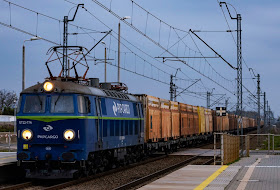News is that ul. Puławska, - that inescapable, unavoidable road into central Warsaw from the south - choked up solid as it is, will get worse. The bridge taking the single track linking Warsaw's Metro to the outside rail network is due for a major remont. Built in 1984 (11 years before the Metro opened), the line links the Metro depot in Kabaty with the railway sidings at W-wa Okęcie. The bridge, spanning eight lanes of traffic (three plus three and two slip lanes) is in poor condition.
Below: from left to right - the acoustic screen of the S2 expressway; the S2 as it reaches its double-hairpin junction (where the traffic lights are); in the distance the work is under way to extend the S2 under the blocks of Ursynów, and the bridge, spanning Puławska.
Below: the bridge was built with walkways on either side. These have been closed off to pedestrians (indeed in the photo above, you can see a chap vaulting over the barrier). While there are steps at the other end of the bridge, there is no access on this side. The railway line itself is extremely rarely used; these days major movements of Metro rolling-stock are done by road (sadly). The only traffic I've seen on this line has been maintenance draisines, maintaining the track for the sake of keeping it maintained. Question - will the bridge continue to provide pedestrian access after the remont?
Further east, where the Metro rail link approaches the main Warsaw-Radom line, and the parallel coal train line. Below: in the foreground, the Metro line curves north, while in the background a bit of a rarity - a former East German loco developed from the Soviet-built M62 (in Poland known as the ST44). Post-unification, the Germans called this class of diesel freight locos BR232; this one is in the livery of CargoUnit, a rolling-stock rental firm, and is heading a rake of empty coal wagons back to Okęcie sidings from Siekierki power station.
Below: the Metro rail link, having crossed Puławska and skirted around the south-western outskirts of Ursynów, cuts through the edge of the Las Kabacki forest before reaching the Metro depot. This is a popular spot for recreation.
Below: a mountain for bikes - Bike Park Kazoora, one of Ursynów's two artificial hills made from builders' spoil from when the blokowiska were being built.
Below: the S2, meanwhile, heads east towards the Vistula (work on the new bridge is continuing on both banks); to get there, the S2 must dive under Ursynów - and indeed, under the Metro. Cut and cover by ul. Płaskowickiej, looking east.
Back by bus to W-wa Okęcie, I walk back along the Metro rail-link from where it starts. The buffers (below) are the symbolic end of the line; the link itself to the rest of the railway network runs to the right of the photo.
Just before I reach the S2 by Węzeł Warszawa Południe, I see a rare sight - a four-engined plane coming into land - an Airbus A340-300. Owned by Maltese airline Hi Fly (registration 9H-FOX), it is currently on lease to LOT Polish Airlines, and has been recently flying the Warsaw-Toronto route. No livery - just plain white. LOT is experiencing difficulty at present, with a pilots' strike and maintenance issues. Leasing planes from other airlines is a stop-gap remedy for the moment.
Below: a LOT Boeing 787 Dreamliner crosses the S79 on final approach to Okęcie.
Back at W-wa Dawidy, I catch a rake of aviation fuel cisterns heading up the coal-train line towards the airport. No longer are the cisterns taken all the way into the fuel depot by rail - a new oil terminal has been built alongside the main railway line (south of the Poleczki viaduct); the fuel is pumped via an underground pipeline to the airport a kilometre away.
Hauled by a NEWAG-refurbished SM42 (now known as a 6Dg) in Lotos livery, the train has just passed three signs warning the driver that the train will be passing points that lead onto an electrified section.
Below: a full load of biomass for co-firing with coal at Siekierki, on its way to Okęcie sidings, hauled by an ET22 loco through W-wa Dawidy station.
It is quarter past five and still light; by tomorrow the clocks go back and the sun sets an hour earlier - 16:14. The hammer of darkness is about to come down once more.
This time last year:
We are what we read, what we watch, what we listen to
This time five years ago:
Extraordinarily warm autumn
This time six years ago:
On behalf of the work-shy community
This time seven years ago:
Classic truck cavalcade
This time eight years ago
Suburban back-roads clogged with commuters
This time nine years ago:
Autumn gold, Łazienkowski Park
This time ten years ago:
Quintessential autumnal Jeziorki
This time 11 years ago:
Google Earth updates its map of Jeziorki












Actually East Germans called this locomotive class 132 (Baureihe 132), only when Deutsche Bundesbahn took over Deutsche Reichsbahn, it was changed to 232. Also, it's not M62/ST44 - in East Germany this class was called V200, then class 120, then in 1990s - BR220.
ReplyDelete@ Anon
ReplyDeleteMany thanks - duly corrected. Good Wikipedia articles in English and Polish about how the M62 was developed.